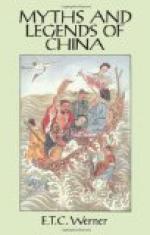To set forth in detail the various phases through which Chinese myth has passed would involve a technical description foreign to the purpose of a popular work. It will sufficiently serve our present purpose to outline its most prominent features.
In the earliest times there was an ‘age of magic’ followed by an ‘heroic age,’ but myths were very rare before 800 B.C., and what is known as primitive mythology is said to have been invented or imitated from foreign sources after 820 B.C. In the eighth century B.C. myths of an astrological character began to attract attention. In the age of Lao Tzu (604 B.C.), the reputed founder of the Taoist religion, fresh legends appear, though Lao Tzu himself, absorbed in the abstract, records none. Neither did Confucius (551-479 B.C.) nor Mencius, who lived two hundred years later, add any legends to history. But in the Period of the Warring States (500-100 B.C.) fresh stimuli and great emotion prompted to mythological creation.
Tso-ch’iu Ming and Lieh Tzu
Tso-ch’iu Ming, commentator on Confucius’s Annals, frequently introduced legend into his history. Lieh Tzu (fifth and fourth centuries B.C.), a metaphysician, is one of the earliest authors who deal in myths. He is the first to mention the story of Hsi Wang Mu, the Western Queen, and from his day onward the fabulists have vied with one another in fantastic descriptions of the wonders of her fairyland. He was the first to mention the islands of the immortals in the ocean, the kingdoms of the dwarfs and giants, the fruit of immortality, the repairing of the heavens by Nue Kua Shih with five-coloured stones, and the great tortoise which supports the universe.
The T’ang and Sung Epochs
Religious romance began at this time. The T’ang epoch (A.B. 618-907) was one of the resurrection of the arts of peace after a long period of dissension. A purer and more enduring form of intellect was gradually overcoming the grosser but less solid superstition. Nevertheless the intellectual movement which now manifested itself was not strong enough to prevail against the powers of mythological darkness. It was reserved for the scholars of the Sung Period (A.D. 960-1280) to carry through to victory a strong and sustained offensive against the spiritualistic obsessions which had weighed upon the Chinese mind more or less persistently from the Han Period (206 B.C.-A.D. 221) onward. The dogma of materialism was specially cultivated at this time. The struggle of sober reason against superstition or imaginative invention was largely a struggle of Confucianism against Taoism. Though many centuries had elapsed since the great Master walked the earth, the anti-myth movement of the T’ang and Sung Periods was in reality the long arm and heavy fist of Confucius emphasizing a truer rationalism than that of his opponents and denouncing the danger of leaving the firm earth to soar into the unknown hazy regions of fantasy. It was Sung scholarship that gave the death-blow to Chinese mythology.




